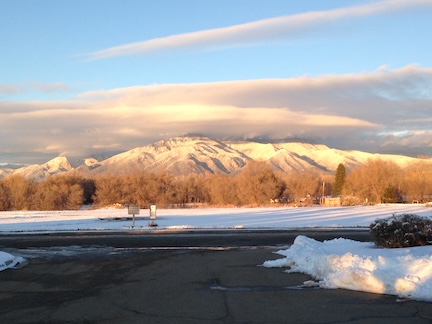Suddenly, we were living at more than a mile high. To be specific, Taos, New Mexico is 6,969 feet high although peaks of the Sangre de Cristo mountains beside it are more than twice that. The high altitude was part of the charm of moving to Northern New Mexico, but, still, there was to be an adjustment.
Afterall we moved from a hilltown in Western Mass. that was only 1,400 feet high. I recall when driving home to Worthington from the Valley, there was a certain spot on Route 143 in Williamsburg aka Burgy, where my ears popped. That was at about a thousand feet. Ah, big deal I found out when we moved in 2006 to Taos.
Now, our bodies had to get used to living where there isn’t as much oxygen due to the reduced air pressure at high elevations. For some people, this can cause headache, nausea, fatigue, dizziness, and shortness of breath. Be careful drinking alcohol.
For me, the higher altitude meant insomnia. No matter how active I was, for the longest time I couldn’t get a good night’s sleep. I took melatonin, which eased it a bit. Also, hiking or even walking at even a moderate pace got my heart revving.
Eventually, my body said, okay, it was used to it.
(We did have to keep in mind the high altitude when we had visitors who were flatlanders.)
And although we were at the same latitude as North Carolina, being that high up meant we had a real winter. There was often a 40-degree difference in day and night temps. The Sangre de Cristos got heavy snow, certainly deep enough to support a ski area — Taos Ski Valley. The snow was dry, not like that wet stuff in Western Mass. Powder days, as they were called, brought smiles to my friends who skied.
The snow that fell up there was important to the mesa down below. When the snow melted, it suppled water to the rivers and acequias, long ditches that irrigated farmland. Every spring, those who used the acequias would make sure they were clear of any debris to keep the water flowing.
We got snow on the mesa below although not as much. The highway crews would be out plowing and using crushed pumice mixed with salt to treat the roads. Their work had an assist from the sunshine and typically, the roads were clear by 10 a.m. because of it. When we first lived there, I noticed sparkling colored pieces on the intersections in the towns. Later I found out, it was ground glass from the bottles people brought to the recycling center. That practice stopped.
On unexpected part of living at such a high altitude was how it impacted baking. I recall using a go-to recipe for a cake, but the darn thing collapsed in the middle and wasn’t cooked properly. Water and soups took longer to cook. Blame it on the lower air pressure.
The problem was solved when my daughter sent me a book: Pie in the Sky Successful Baking at High Altitudes by Susan G. Purdy. Her recipes adjust for several heights — from sea level to 10,000 feet. I still use it.
And now, I live in a village that’s 400 feet — a piece of cake, really.
